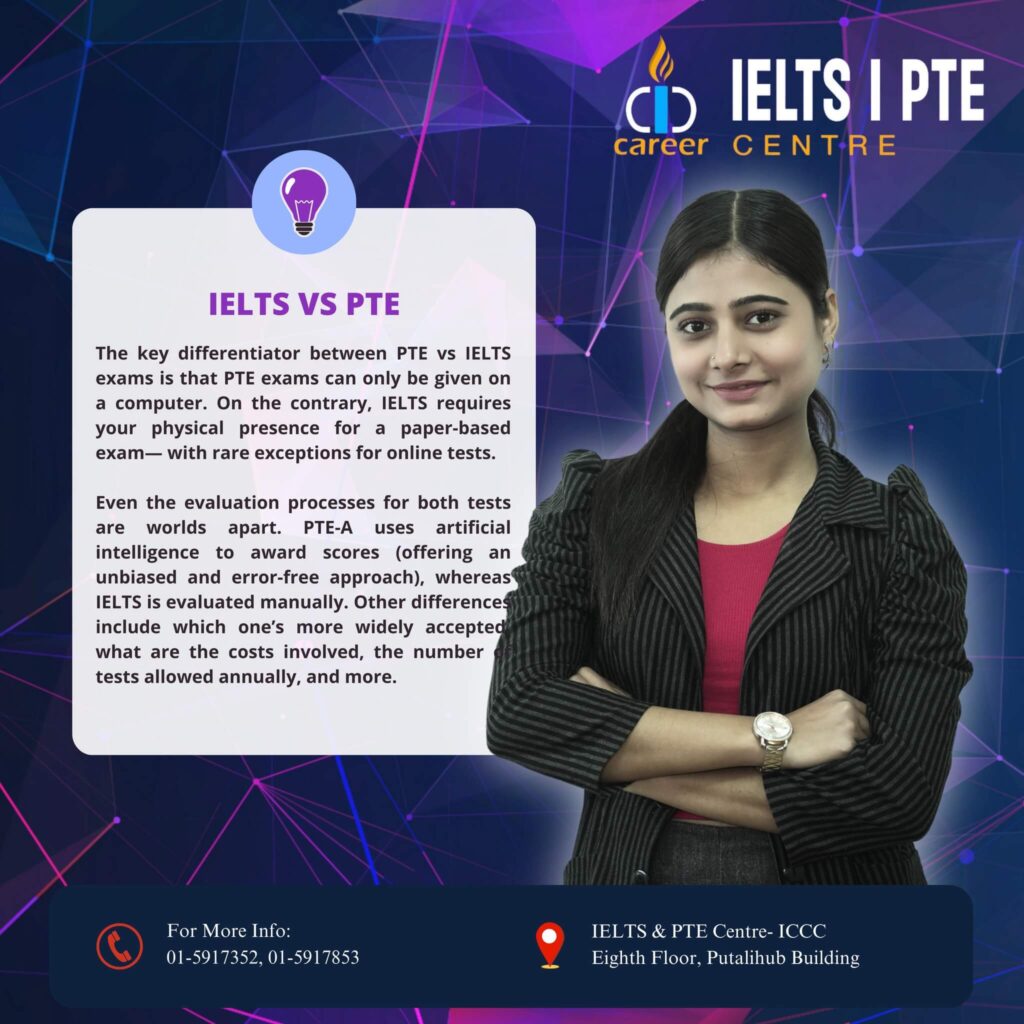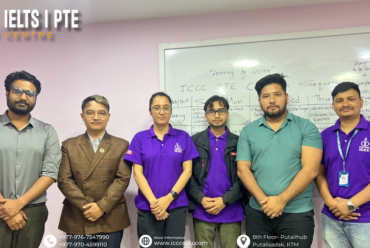IELTS vs PTE
There are many language- proficiency tests available in the market that have their significance as per requirements and associated perks. Out of all, English holds a major credit for bringing people from different backgrounds together on a common platform. Yes, the whole world has indeed become a global village due to communication, but it would have been impossible if it were not for English. Hence, English is popular with nearly a quarter of humanity on Earth.

While English may not be the most spoken language globally, its universal popularity is undeniable. Spanning over 50 countries and embraced as the primary language by over 400 million individuals worldwide, English stands as a powerful tool for cross-cultural communication.
The widespread significance of English fuels a growing trend: the desire to master this pervasive language. As the world becomes increasingly interconnected, the ability to effectively communicate with people from diverse backgrounds becomes essential. Thus, the allure of mastering English extends beyond linguistic proficiency; it represents a gateway to forging meaningful connections and navigating the complexities of our globalized world.
Introduction to IELTS and PTE
IELTS is an international language test, jointly owned by the British Council, IDP: IELTS Australia, and Cambridge Assessment English. IELTS also assesses all four communicative skills. The listening, reading, and writing components are completed in a secure examination setting on the same day and can be delivered either on paper or computer. The speaking component is assessed separately through a face-to-face interview up to a week before or after the written test. The reading and listening sections consist of closed-question types. Writing is assessed through two task types (information synthesis and essay-based) and speaking is assessed through three task types (everyday questions, a monologue, and a discussion).

PTE Academic is a computer-based international English language test. It assesses test takers’ English language competency in listening, reading, speaking, and writing. The test uses 20 item types reflecting different modes of language use and response formats through a combination of single-skill and integrated skills tasks.

IELTS to PTE Conversion:
Imagine, that if you have an IELTS score of 7.5 in each section, you may want to convert it to a PTE score. You can do this using conversion charts or online tools offered by official testing organizations. Let’s say the conversion indicates that your equivalent PTE score falls between 76 and 83. Essentially, this means that based on the conversion method applied, a proficiency level reflected by an IELTS score of 7.5 corresponds to a particular range within the PTE scoring system.
PTE to IELTS Conversion:
Conversely, when you achieve a PTE score of 84, it’s important to explore how this outcome correlates with the IELTS scale. By employing dependable conversion techniques, you may discover that a PTE score of 84 corresponds to an impressive IELTS score of 8.0. This adaptability enables individuals to assess their language proficiency within the framework of either assessment.
Difficulty Level
IELTS: Known for its diverse range of accents in listening and the need for precise articulation in speaking. The writing section often requires a clear understanding of formal language and essay structure.
PTE: Considered by some as more predictable and less challenging, with a focus on academic language proficiency across all sections.
As per the Source: IELTS Partnership Research Papers: Studies in Test Comparability Series Investigating the relationship between IELTS Academic and PTE-Academic it was found that IELTS has been more challenging than PTE.
Source of Research: 2020 Concordance Report PTE Academic and IELTS Academic https://www.pearsonpte.com/ctf-assets/yqwtwibiobs4/1hXHbkTLYCJly7JryACWjK/5a20dbe26d8ca2c36a3b0dd5a32868d7/2021_PTEA_2020_PTE_IELTS_Concordance_White_Paper.pdf
Test acceptance
| IELTS | PTE Academic |
| IELTS is trusted for migration by the governments of the UK, Australia, Canada, and New Zealand.IELTS is trusted globally by more than 11,000 organizations including universities, professional bodies, employers, and governments. | PTE Academic is accepted for visa purposes by the Australian and New Zealand governments.PTE Academic is accepted by thousands of universities worldwide. |
Speaking test
| IELTS | PTE Academic |
| Speak to a person, not a robot!The IELTS Speaking test is face-to-face with a human examiner in a private and quiet room with no other test takers.
To be fair to test takers, IELTS Speaking examiners may repeat or rephrase a question upon request. | PTE Academic test takers are tested by their ability to produce spoken English in an academic environment (reading aloud in a partitioned booth with other test takers in the room).The Speaking test microphone will switch off automatically if a test taker is silent for more than 3 seconds. |
Reviewing answers during your test
| IELTS | PTE Academic |
| In IELTS on the computer, you may skip questions and come back to them to complete or check your answer at a later time.This is fairer, as we understand you may want to review or change your answers. | In PTE Academic you can only navigate forward through questions and you must correct mistakes before moving on to the next question. |
Source: https://ielts.idp.com/pakistan/prepare/article-ielts-test-vs-pte-academic-test
It is evident that the two tests serve similar populations and purposes and have some commonalities in the underlying constructs of the four language skills. However, the operationalisation of the constructs varied to a large extent. Several assessment methods are unique to PTE; for example, integrated assessment is a prominent feature of several PTE tasks (e.g. summarise written text, summarise spoken text, retelling lectures, and describe images), which are also linguistically and cognitively more demanding than other tasks. The difficulty level of IELTS tasks is more balanced across the papers but the difficulty level of the PTE tasks varies to a greater extent within a paper. Some PTE tasks look more authentic, academic-oriented, and demanding, but their difficulty might be canceled out by easier tasks that assess mainly, if not solely, lexical knowledge and local-level comprehension of the inputs.
Both tests, IELTS and PTE, have similar levels of difficulty in terms of thinking and language skills, but each section (Speaking, Writing, Listening, and Reading) may have its differences. Another big difference is how they calculate scores. IELTS gives clear details about how they score each question and task, but PTE doesn’t provide as much information about how they weigh different question types and skills to calculate scores. This lack of transparency makes it harder to compare the two tests accurately.
PTE or IELTS: Which is for you?
When deciding between PTE and IELTS, consider the following factors to determine which test is better suited for you:
Comfort with Technology:
- If you are comfortable with computers, typing, and navigating through digital interfaces, PTE might be a preferred choice as it is a fully computer-based test.
- If you prefer a traditional pen-and-paper format, IELTS, with its paper-based option, may be more suitable.
Result Turnaround Time:
- If you have tight timelines and need quicker results, PTE is known for its faster result processing, typically within 5 business days.
- If you can afford to wait for about 13 days for your results, IELTS might still be a viable option.
Language Skills Strengths:
- Consider your strengths and weaknesses in different language skills. IELTS assesses four distinct skills (listening, reading, writing, speaking), while PTE integrates these skills in its three sections.
If you excel in integrated tasks, PTE might be a good fit. If you prefer separate assessments for each skill, IELTS might suit you better.
Target Institution or Country Requirements:
- Check the specific requirements of the educational institutions or immigration authorities you are applying to. Some institutions or countries may have a preference for one test over the other.
- If your target institution or country accepts both tests, consider your personal preferences and strengths.
Test Format Preferences:
- If you have a preference for a specific test format based on practice tests or personal experience, that should influence your decision.
- Take sample tests for both PTE and IELTS to see which one aligns more with your testing style.
Cost Considerations:
- Compare the test fees for both PTE and IELTS. While the cost difference may not be significant, it’s a practical aspect to consider.
Flexibility in Test Dates:
- If you need flexibility in choosing your test date, PTE offers year-round availability with more options.
- IELTS also has frequent test dates but might have slightly fewer options depending on your location.
In conclusion, the decision between PTE and IELTS should be based on a combination of your strengths, preferences, and the specific requirements of your target institutions or countries. Both tests are widely accepted, so it’s essential to choose the one that aligns best with your skills and the expectations of your chosen path.







